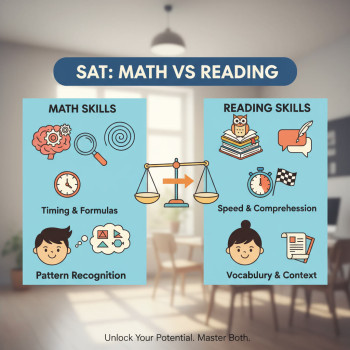Why a weekly routine matters more than a cram session
Imagine waking up on test day calm, confident, and ready—because your weeks leading up to the Digital SAT were thoughtful, purposeful, and predictable. That’s what a well-built weekly routine buys you: steady momentum, fewer panic spirals, and an honest picture of what’s improving and what still needs attention. The Digital SAT’s format and official practice ecosystem make it easier to practice smart, not just hard. Building a weekly routine serves two big functions: it trains your skills and it trains your test-taking habits (timing, pacing, and comfort with the digital tools). ([satsuite.collegeboard.org]( with understanding the test—then design your week around it
Before you pencil anything into your calendar, get familiar with what you’ll face on test day. The Digital SAT is shorter than the old paper SAT, offers more time per question, and runs on the Bluebook testing app. There are adaptive elements and built-in tools—so your practice should include full digital practice tests and shorter skill sessions. Use the official practice tests in the Bluebook app and the Official SAT Practice resources to simulate real test conditions and to focus your practice where it will matter most. ([satsuite.collegeboard.org]( quick questions to answer first
- How many weeks until my test date? (This determines the scope of your plan.)
- What are my target scores and current baselines? (Score reports from practice tests will help.)
- Which sections cause the most stress—Reading & Writing, Math, or pacing across sections?
Components of an effective weekly routine
An effective week combines four building blocks: focused skill work, timed practice, review and reflection, and wellness habits. Spread across the week, these parts keep your brain hungry for improvement and reduce burnout.
1. Focused skill sessions (3–4 times per week)
Pick one or two narrow skills per session—vocabulary-in-context strategies, algebraic manipulations, data interpretation, or passage mapping. Keep these sessions short and intense: 45–60 minutes with a single learning objective and 10–15 minutes of active review at the end.
2. Timed practice (1–2 sessions per week)
Timed practice recreates the pressure of test day. Use the Bluebook practice tests or the test preview to practice the digital interface and adaptive format. Alternate between full mini-sections and a full-length adaptive practice test every 1–2 weeks to build stamina and monitor progress. ([satsuite.collegeboard.org]( Review and error log (ongoing)
After every practice session, spend time analyzing mistakes. Keep an error log that records the question type, the mistake, the correct approach, and an action step. Over time this log reveals patterns—like careless arithmetic errors or trouble with evidence-based reading questions—and lets you adjust your skill sessions.
4. Well-being and test habits (daily)
Short, daily habits matter as much as long study blocks. Sleep, hydration, short physical activity, and a brief mindfulness or breathing practice before studying can noticeably improve concentration. Also practice with the exact device and setup you’ll use for the test (Bluebook compatibility, chargers, headphones if allowed) so nothing is surprising on test day. ([satsuite.collegeboard.org]( sample weekly schedule you can personalize
Below is a balanced week built for students with about 10–12 hours per week to commit to SAT preparation. Adjust the times to match your school schedule, extracurriculars, and energy levels.
| Day | Activity | Time | Goal |
|---|---|---|---|
| Monday | Focused skill (Math: algebra & functions) | 60 min | Master 3–4 problem templates; add to error log |
| Tuesday | Reading practice (passage mapping & main idea) | 45 min | Practice two passages under timed conditions |
| Wednesday | Timed section or mini-test (digital) | 60–90 min | Simulate test conditions using Bluebook; review mistakes |
| Thursday | Grammar & Writing (R&W skills) | 45 min | Target sentence corrections and rhetorical skills |
| Friday | Mixed practice + review week’s error log | 60 min | Rework errors and re-attempt similar problems |
| Saturday | Full-length digital practice test or longer simulated block | 2–3 hours | Assess progress and pacing; practice test-day routine |
| Sunday | Light review & wellness | 30–45 min | Reflect on week; plan next week; active recovery |
Why Saturday testing works
Scheduling the longest practice on a non-school day reduces stress and gives you time to process the results. Treat it like a dress rehearsal: wear what you’d wear on test day, charge your device, and follow your morning routine. Practice with Bluebook for the most realistic digital simulation. ([satsuite.collegeboard.org]( to use practice resources effectively
Official resources are designed to replicate the Digital SAT experience. Use them smartly:
- Bluebook practice tests: Use for timed sections and full-length simulations. They’re the best way to get used to the adaptive digital interface. ([satsuite.collegeboard.org](
- Official SAT Practice on Khan Academy: Use for targeted skill drills and personalized practice plans. It’s great for reinforcing concepts your diagnostics flag. ([satsuite.collegeboard.org](
- Student Question Bank/My Practice: Create custom sets of questions that match your weaknesses and practice them repeatedly until you develop reliable strategies. ([satsuite.collegeboard.org]( Idea : A student at a tidy desk with a laptop open to a practice test on the Bluebook interface, a notebook with an error log, highlighter pens, and a glass of water—conveys focused, realistic test prep.
Making progress measurable: what metrics to track each week
Tracking progress isn’t just about the raw practice test score. Here are the metrics that matter and how to use them:
- Timed accuracy by question type (e.g., data interpretation, algebra, command of evidence)
- Average time spent per question/section
- Number of careless errors vs. conceptual errors
- Stamina—can you finish full sections without major fatigue?
- Confidence levels on each question (survey yourself after practice)
Record these in a weekly log. If your accuracy on algebra problems increases but your time-per-question climbs, you know you’ve traded speed for precision and should work on paced drills.
Sample 8-week plan: from baseline to test-ready
For students with roughly two months before test day, split your plan into phases: diagnostic, skill-building, simulation, and final polish. Here’s a condensed weekly structure.
Weeks Focus Weekly Goal 1–2 Diagnostic + core skills Take 1–2 full Bluebook practice tests; identify top weaknesses 3–4 Targeted skill-building Systematically address top 3 weak areas with drills 5–6 Timed practice and pacing Increase timed sections; reduce time-per-question variance 7 Full-length simulation every weekend Match test-day routine; analyze remaining error patterns 8 Polish and rest Light practice, strategic review, and sleep prioritization Daily micro-routines that add up
You don’t have to study for hours every day. Smart micro-sessions are powerful.
- 15 minutes: vocabulary in context—practice with sentence-level questions or flashcards
- 20 minutes: two reading questions with passage mapping
- 30 minutes: one focused math topic with 6–8 practice problems
- 5–10 minutes: quick review of your error log
These micro-routines are especially effective the week before your test when you want to keep skills sharp without building fatigue.
How to recover when you hit a plateau
Plateaus are normal. When weekly scores stagnate, take these steps:
- Return to fundamentals. Relearn a concept from first principles rather than repeating the same drills.
- Change practice format. Switch from untimed skill work to full digital sections to change context.
- Bring in outside perspective. A short session with an experienced tutor can identify subtle strategy flaws. This is where Sparkl’s personalized tutoring can fit naturally: short, targeted 1-on-1 sessions with an expert tutor who designs a tailored study plan often reveal small, high-leverage changes that break plateaus—like a new approach to evidence-based questions or a pacing tweak. Use AI-driven insights from tutors to prioritize weak areas efficiently.
Practical tips for staying consistent
Consistency beats intensity. Here are small but practical strategies that keep your weekly routine alive:
- Block your study times on your calendar the same way you’d block a class—consistency builds habit.
- Set two weekly goals: a performance goal (e.g., increase accuracy on algebra by 5%) and a process goal (e.g., complete three error-log reviews).
- Use environmental cues—same desk, same playlist, a short pre-study ritual (two deep breaths + 30 seconds of review).
- Celebrate micro-wins. Finished a tough practice test? Celebrate with a short walk or a favorite snack—this reinforces your habit loop.
Photo Idea : A small flat-lay image of a weekly planner, colored pens, a phone showing a Khan Academy practice plan, and a sticky note reading “Test Day: Be Ready”—communicates organized, tech-enabled prep. Test-day week: what to taper and what to practice
During the final seven days, reduce volume and sharpen quality. Keep sessions short: 30–90 minutes with a focus on timing and light review. Avoid introducing new strategies in the last 72 hours—this is not the time for big experiments.
- 7–5 days out: one shorter digital practice section every other day; focused review of the most frequent error types.
- 4–2 days out: light practice and logistics planning (download Bluebook, check device, plan route to test center). ([satsuite.collegeboard.org](
- 1 day out: rest, sleep early, quick 20–30 minute relaxed review of formulas and strategies.
When and how to use tutoring effectively
Tutors can speed up progress if used for clear objectives: diagnosing persistent mistakes, learning a new strategy quickly, or fine-tuning pacing. If you work with a tutor, make each session actionable: bring your error log, practice test, and specific questions. A personalized tutor can build a tailored weekly plan and provide accountability. Sparkl’s approach to personalized tutoring—1-on-1 guidance, tailored study plans, expert tutors, and AI-driven insights—can slot into your weekly routine as a weekly check-in or emergency deep-dive, depending on your needs.
Common mistakes students make when building weekly routines
Knowing what to avoid is as helpful as knowing what to do. The most common missteps:
- Studying without a diagnostic baseline—aiming at the wrong target wastes time.
- Only practicing untimed questions—this causes pacing surprises on test day.
- Ignoring review—repeating mistakes without learning from them won’t change scores.
- Overdoing it in the final weeks—burnout reduces performance more than a lack of prep.
The mindset that turns routine into progress
Think like a coach, not a doer. A coach analyzes data, sets micro-goals, and adjusts. Let test results guide your weekly priorities. When a practice test shows a recurring error pattern, treat it like a clue rather than a failure. Curiosity and small, data-driven adjustments compound into significant gains.
Final checklist: your weekly routine readiness
- Have you taken a full digital practice test in Bluebook? (Baseline)
- Do you keep an error log updated after every practice?
- Are your focused skill sessions targeted to your top three weaknesses?
- Do you simulate test-day conditions at least weekly?
- Is your device and Bluebook setup tested and ready?
- Do you include short daily wellness habits (sleep, movement, brief relaxation)?
Parting thought: consistency compounds
Building a weekly routine for the Digital SAT is not about heroics—it’s about repeatable systems that make improvement inevitable. A deliberate week of focused skill work, timed practice, careful review, and rest will carry you farther than any last-minute marathon. Use official digital practice (Bluebook and Official SAT Practice) to keep the experience realistic, rely on your error log to shape each week, and bring in personalized help—like Sparkl’s tutoring—when you need fast, expert course corrections. Stick to the plan, track the data, and give yourself permission to rest: the test will meet a prepared, confident you.
Want a custom weekly plan?
If you’d like, I can draft a personalized 6–8 week weekly routine based on your current schedule, target score, and recent practice results. Tell me your baseline score and how many weeks you have until test day, and I’ll map out a realistic, tailor-made plan.
Good luck—and remember: consistency plus feedback beats last-minute intensity every time.

















No Comments
Leave a comment Cancel